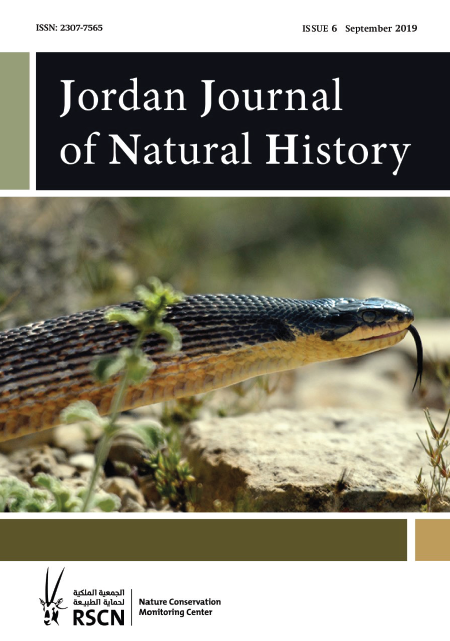Articles
Status and Conservation of the Striped Hyena (Hyaena hyaena) in the Occupied Palestinian Territories (West Bank)
Author Name
Elias N. Handal, George H. Qumsieh, Shayma Y. Hammash and Mazin B. Qumsiyeh
The striped hyena (Hyaena hyaena) in Palestine is one of the four living hyena species in the whole world. There have been no studies on the status of the striped hyena in the West Bank over the past twentyfive years. Therefore, this paper presents a detailed study based on data collection and field observations (including camera traps) that add to the existing knowledge about this unique carnivorous mammal. The researchers collaborated with the Environmental Quality Authority in the new animal rehabilitation unit which provided the researchers with both deceased and confiscated animals. The observations in this study significantly extend the distribution range of the hyena from the eleven localities reported earlier to over twenty localities. The study also discusses the educational efforts that were made to raise awareness and address the myths that allow people to kill hyenas, including the enforcement of the 1999 environmental law, and the prospects for the future of hyena populations. The researchers are cautiously optimistic concerning the future of this species especially in light of the education and awareness campaigns in addition to the more strict enforcement of laws by the EQA and the newly-established environmental police units. One challenge remains open which is the Israeli occupation that limits the accessibility of Palestinian officials to 60% of the West Bank which harbors some 90% of the hyena habitats in the Palestinian territories.
A Post-Hatch Study of Larynx and Syrinx in Kuttanad Ducks (Anas platyrhynchos domesticus)
Author Name
Firdous A. Dar, Maya S. Krishnan and Ashok N. Pillai
A developmental study of the larynx and syrinx in Kuttanad ducks was carried out using seventy-eight female birds ranging from one day to twenty-four weeks of age. The material was collected from six birds in each group at fortnightly intervals. Caudal to the base of the tongue protruding on the floor of the pharynx was a conspicuous elevation, known as the laryngeal mound. In this study, it is a raised, elongated lozengeshaped structure occupying the caudal third of the floor of the pharyngeal cavity. The larynx is formed by cricoid, procricoid and paired arytenoid cartilages which become ossified with progression of age. The procricoid was found to be the smallest median cartilage of the laryngeal skeleton placed dorsally. An increase in the laryngeal length and width was observed as the age advanced; both attained their maximum value by the eighteenth week of age. The laryngeal mound is covered by stratified squamous epithelium with numerous pointed caudally directed papillae. These papillae are covered by the keratinized epithelium. The syrinx is a laterally dilated organ, situated ventral to the esophagus above the base of heart at the thoracic inlet, suspended within the clavicular air sac. In Kuttanad ducks, the syrinx is of a tracheobronchial type; viz. formed by the transformed six caudal rings of trachea and four to five rings of extrapulmonary primary bronchi. The skeleton of the syrinx consists of three components, namely the cranial cartilages (tympanum), rings of the dilated part, and the pessulus. The length of the syrinx increased linearly from the first day to the twenty-fourth week of age recording a maximum growth by week twenty-four. The width of the syrinx also increased with age. A slight decrease was observed in twentyweek- old birds followed by an increase in the succeeding groups.
Notes on the Pigeons and Doves (Family Columbidae) Occurring in the Gaza Strip – Palestine
Author Name
Abdel Fattah N. Abd Rabou and Mohammed A. Abd Rabou
Birds are the commonest terrestrial vertebrates among the fauna of the Gaza Strip. Hundreds of bird species have been recorded and more records are being added continually. Columbids (pigeon and doves), constitute a prominent component of birds, yet they have never been separately studied in the Gaza Strip. The current study aims at giving useful notes on the doves and pigeons occurring in the Gaza Strip. Field visits, observations, photography, and discussions with stakeholders were carried out to reach the goals of the study. Seven species of pigeons and doves were recorded in the Gaza Strip. The Rock Pigeon (Columba livia) was found to be the commonest while the African Collared Dove (Streptopelia roseogrisea) was the rarest. Different plumage colors of the Barbary Dove (Streptopelia risoria) are easily reared and traded in local zoos and pet shops. All pigeon and dove species are subject to poaching and hunting for different purposes including meat and pet trade. Finally, the study recommends raising ecological awareness among Gazans and the implemtation of protection measures in order to sustainably conserve bird fauna in the Gaza Strip.
Potter Wasps (Hymenoptera: Vespidae, Eumeninae) as Hosts of Amobia Robineau‒Desvoidy, 1830 (Diptera: Sarcophagidae, Miltogramminae) in Ukraine
Author Name
Yuri G. Verves and Yuri V. Protsenko
Amobia signata (Meigen, 1824) was reared from the nests of eumenine wasps Symmorphus bifasciatus (Linnaeus, 1761), Discoelius zonalis (Panzer, 1801), and Amobia oculata (Zetterstedt, 1844) from S. bifasciatus in Ukraine. Both species of wasps are the new hosts for those flies. A. oculata was firstly recorded from Poltava region. All recent published data on hymenopteran hosts and the distribution of both species of flies are processed and listed.
An Additional Locality Record of the Blotched Rat Snake, Elaphe sauromates (Pallas, 1814) (Reptilia: Colubridae) in Syria
Author Name
Ahmad Qawi, Nazir Khalil and Zuhair S. Amr
The present note provides an additional locality record of the rare Blotched Rat Snake, Elaphe sauromates (Pallas, 1814) from Syria. An updated map of its current distribution across Syria and Lebanon is presented.
A Recovery of a Lanner Falcon Falco biarmicus Suggesting a Possible Movement Pattern in the Jordan’s Breeding Population
Author Name
Mohammed Al Zoubi, Ashraf El-Halah, and Nashat A. Hamidan
The numbers of raptors admitted to the Royal Society for the Conservation of Nature’s (RSCN) Rehabilitation Center have increased over the past decade, with a total of 140 raptors treated, ringed and released. Among these raptors is the Lanner Falcon Falco biamicus, which had been ringed and released on the third of August, 2017, after spending nearly 580 days in the Rehabilitation Center. 445 days following its release, a telephone call from a falconer was received confirming the capture of this individual Falcon in Al Hafirat, Madinah Province, Saudi Arabia, nearly 850 km away from the released site. This piece of information suggests the occurrence of a possible movement pattern of this species. The confiscation of juveniles’ lanner falcons over the past four years indicates that a possible breeding population still exists in Jordan. However, more detailed surveys are needed to confirm its breeding in Jordan in addition to modern tracking technology to determine the movement patterns of the
species.
The First Record of a Bat Found Ensnared by a Plant in the Occupied Palestinian Territories
Author Name
Elias N. Handal and Mazin B. Qumsiyeh
This is the first documented record of a bat ensnared by a plant in the Arab world. Kuhl’s pipistrelle, Pipistrellus kuhlii (Kuhl, 1817), was caught on the Holy Hawksbeard, Picris altissima L. Delile, in Bethlehem, the Occupied Palestinian Territories (West Bank).
Massylaea vermiculata (O. F. Müller, 1774): A Serious Land Snail Pest Introduced to Jordan
Author Name
Zuhair S. Amr, Mohammad Abu Baker and Ahmad Katbeh- Bader
A heavy infestation of Massylaea vermiculata in an olive farm located in the eastern desert of Jordan is reported




